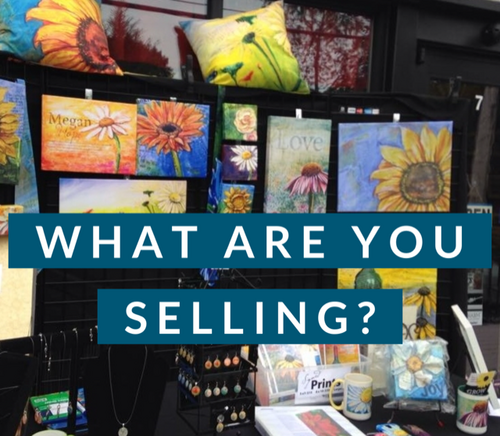by Carolyn Edlund
You’re selling art or handmade goods, right? But what exactly are you selling? Making additions and changes to your product offering can maximize your earning potential.

As a creative entrepreneur, you may want to cultivate more than one stream of income. Fortunately, there are multiple ways to earn as an artist. These include developing products from your work in different formats that can be sold in different markets.
Selling original art is one way to earn income. But if you only offer originals, every piece for sale must be created one at a time “from the drawing board.” Leverage your artwork instead by making it once and selling it over and over. This increases your sales volume and saves you time and effort.
Leverage can be gained by offering work for sale in different formats to buyers in different sales channels. Let’s look at a few options:
Print Reproductions
One common way to leverage 2D work is to produce reproductions, commonly known as prints. There are a huge number of options for artists who add reproductions into their arsenal of products. Substrates for printing wall décor vary from paper to canvas, aluminum, wood, acrylic and more. Print finishes range from matte to gloss and everything in between.
Print size is another consideration, limited only by your digital files and the restrictions of the printer. Obviously, it’s impossible to offer every option. Nor would this serve your customers, who could be easily overwhelmed by an unmanageable number of choices.
If you want to sell reproductions of your work, start by investigating fine art printers. Review their selection of substrates, finishes and sizes. Obtain sample prints of your art when possible and decide which formats best suit your audience. This will give you a starting point to build out your product collection. Offering reproductions for sale is also a great way to spread your price points. It allows you to reach new prospective customers who cannot afford to purchase an original or commission a work, but want to own your art.
Beyond the category of wall décor, there are other print substrates that transform your artwork to use as wallpaper, hang as outdoor art on a building, or even wrap a car. Your chosen audience may be individuals or commercial clients, and there are plenty of options to satisfy the needs of all of them.

Reproductions are a popular format for 2D art and photography.
Merchandise
This category often takes the form of print-on-demand products created and shipped to the customer by third party providers. If your designs are appropriate for home products, wearables, or accessories, sales of these products could provide a stream of income.
Print-on-demand providers most often run websites where you can create a profile, choose products, upload your art and start selling. They may integrate with template website platforms such as Shopify or Squarespace. This allows you to sell a variety of merchandise directly from your own art website. With integration, orders seamlessly flow through to the provider for production and delivery.
Some artists work directly with manufacturers to produce products with their designs, to be sold in the retail or wholesale marketplaces. This usually results in a lower per piece cost, but also involves meeting order minimums and holding inventory.
Digital Works
You can literally sell art in digital format, and many artists do. One avenue is to create and sell printable art online, instantly delivered to the customer as a download. Products in this category include frameable art, calendars, planners, workbooks, cards and other items. They may be sold through your art website or on a third-party platform such as Etsy.
NFTs are digitally created artworks that have proven to be hugely popular with a wide global audience. They are sold and delivered through online marketplaces based on blockchain technology. Payment is made in the form of cryptocurrency, usually Ethereum. Learn more about NFTs and crypto art here.
Another way to leverage your art digitally is to allow reproduction by a third party through a licensing agreement. Licensing is a multi-billion-dollar industry. Individual artists can become licensors by entering into contracts with and delivering art digitally to licensees, which are usually manufacturers. Although there may be custom work involved, this is mostly a passive stream of income. Payment is typically in the form of royalties paid on a quarterly basis.
Customize Your Product Mix
These options are just some of the many product types and markets available to creative entrepreneurs. If you’re looking to broaden your product selection and price range, carefully consider which formats are right for you. Take a look at your sales history. What are your customers looking for? Which products and categories are most appropriate for your portfolio? Where do your interests lie?
Get started by creating a small selection of new products and test the market first. Then gauge your results and make necessary adjustments before committing to a large offering.

Speak Your Mind